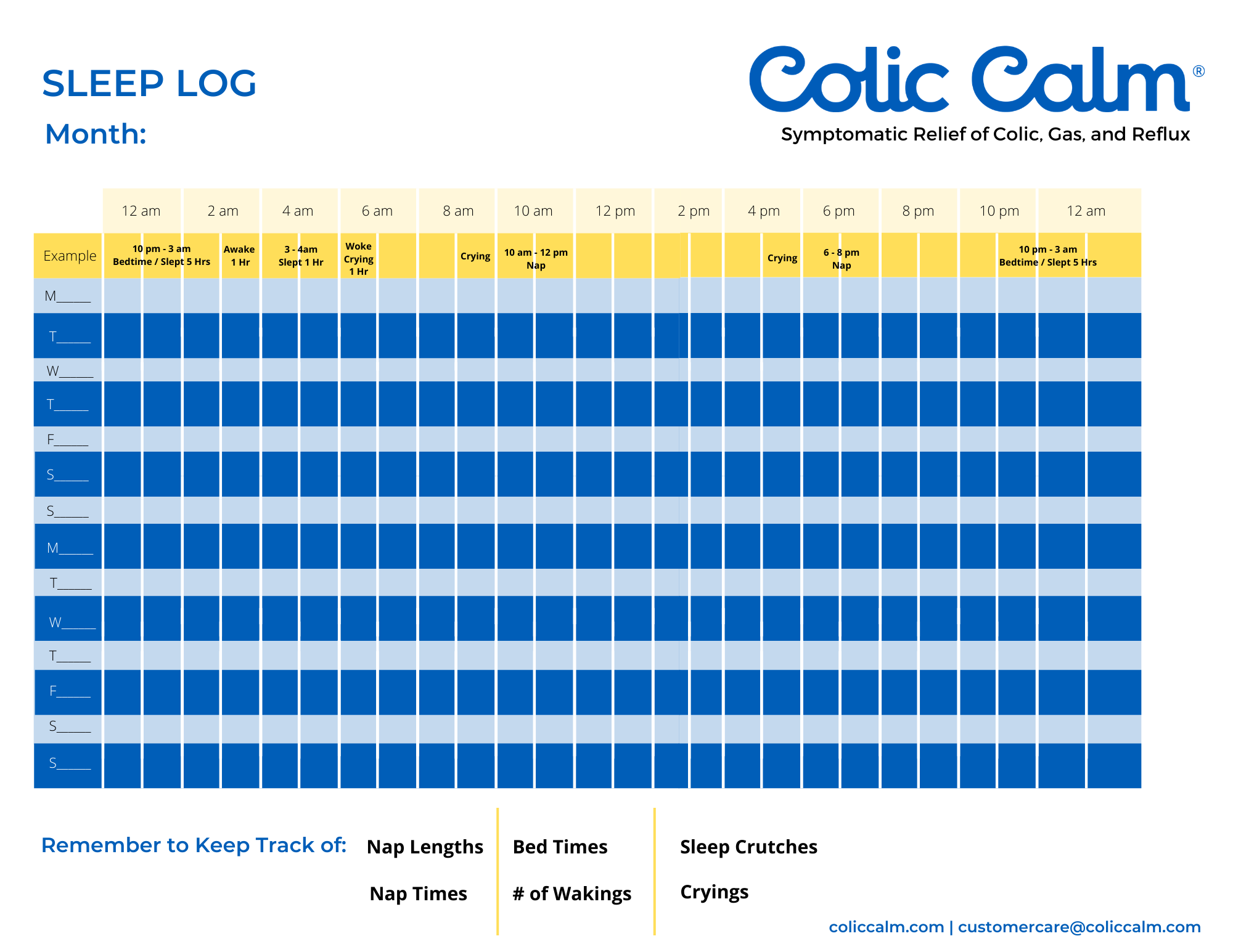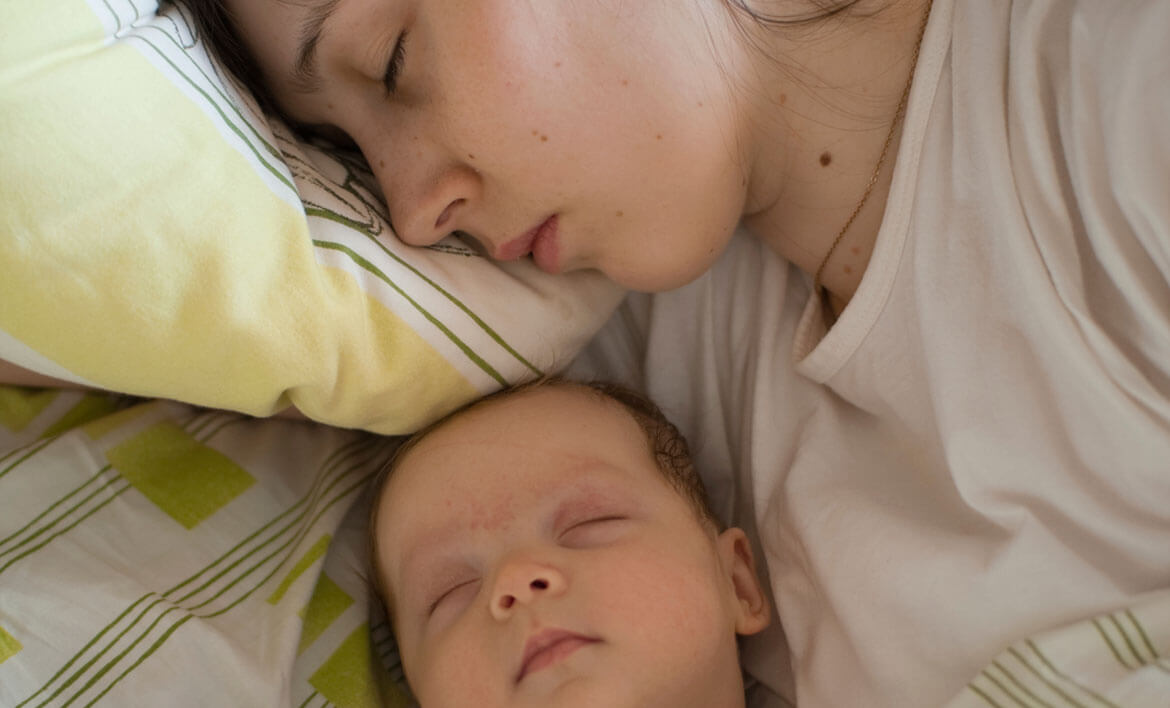Note About the 4-Month Sleep Regression
For parents who have suffered through months of colic, the last thing that you want to hear is that your baby may have even more sleep issues. Though unfortunate, most babies do experience at least a few weeks of sleep regression right around 4 months, although some babies begin to exhibit regression characteristics as early as 3 months or as late as 5 months. Sleep regressions imitate colic, but not to the extreme that you’ve previously experienced, and it’s not wise to begin any sleep coaching while your baby is mid-regression.
Know that a sleep regression is actually a good (albeit frustrating for you) thing! Sleep regressions indicate a developmental leap that your baby has made (rolling over, sitting up, walking, etc.), and they usually last anywhere from 2 to 6 weeks. You’ll want to wait until your baby is out of the 4-month sleep regression before you begin to change their sleep routine.
You made it! You’ve survived your baby’s colic, and it’s quite likely that you’ve been living on very little sleep for the past few months. Hopefully you were able to take some of my tips and apply them to help you get as much sleep as possible during those challenging months. When you have a baby with colic, you have to do whatever works, which creates sleep crutches, quite often multiple crutches. It’s perfectly understandable that when you aren’t sleeping, and baby isn’t sleeping AND won’t stop crying, you get a little desperate. Everyone does!
Most cases of colic subside around the 3 to 4-month mark, which allows parents a reprieve, as well as time to introduce some gentle sleep strategies. While 3-months is quite often too young to use traditional sleep coaching methods, parents can help encourage positive sleep habits so that when their baby develops the ability to self-soothe.
Often, babies as young as 18 weeks (assuming that your baby is not going through the 4-month sleep regression) are ready for gentle sleep coaching. When it comes to babies with colic, however, you’re dealing with more sensitivity, and they may not be ready to sleep coach this early. Don’t fret, usually around 6 months, even babies who have suffered from colic are ready for gentle sleep coaching. Please check with your pediatrician before you begin any type of sleep coaching, and use your best judgment about your baby’s readiness.
Once you’ve come out of your baby’s colic phase, I’m sure that you’re ready to make some positive changes when it comes to your baby’s sleep, which often means sleep coaching. Before you get started, please speak to your pediatrician and make sure that your baby is ready for such a big change, especially if your baby is younger than 6 months.
5 Steps To Building Healthy Sleep Habits
1. Create a Positive Sleep Environment
Make sure that your baby’s sleeping space is dark, cool, and quiet to encourage sleep. If you need to put in blackout curtains or purchase a white noise machine to make this happen, you’ll find that it’s well worth it.
2. Make Sure Your Baby is Exposed to Natural Light During the Day
Natural light helps our bodies regulate melatonin. Exposing your baby to natural light either by opening the windows or going on a short walk in the mornings and afternoons will help your baby to establish the difference between day and night (and no, your baby really doesn’t know the difference!). For most babies, this should not be an issue by 4 months.

3. Keep a Sleep Log
About 2 weeks before you want to begin sleep coaching, keep a sleep log that you can refer to going forward. Record naptimes, nap length, bedtimes, number of night wakings, and any crutches or crying.
4. Know Your Child’s Sleep Crutches
Sleep Crutches are something that nearly every baby that I’ve ever encountered has, and in order to effectively sleep coach, you’ll need to identify your child’s crutch. Remember, up to at least 4 months and often 6 months, these crutches are necessary, as your baby truly cannot put himself to sleep. The good news? This gives you time to answer this question: what HAS to happen for your baby to fall asleep? Is it the swaddle? Or rocking? Bouncing? Singing? Patting? Does your baby have to have the pacifier? Or a combination of several of these? Once you know your baby’s sleep crutch, you have a good idea of what you’ll be dealing with when you begin sleep coaching. Know that not all crutches are considered “poor habits,” in fact, a pacifier or swaddle may be an effective method that helps your child sleep.
5. Establish a Consistent Bedtime Routine
Having an established bedtime routine is paramount to sleep coaching success. Your bedtime routine does not need to be long and involved, but it does need to be consistent and at the right time—your baby’s bedtime sleep window. Choose 2-3 things that you do consistently every night, and make that your routine. Many families find that a feeding, snuggle, and song or book are perfect. You can shorten the routine to just a feeding and snuggle before naps to help your baby begin to recognize sleepy times.
Getting Started

When you’re thinking about creating good sleep habits, it’s important that you lay some groundwork before you start teaching your baby to sleep.
Once you’ve laid the groundwork, it’s just a matter of making sure that your baby is ready for sleep coaching. If your baby has suffered from colic, I strongly recommend that you speak to your pediatrician about your plans and make sure that your baby is medically ready for sleep coaching. Please do this even if all signs of colic are gone.
When talking about sleep coaching, there are four main methods that every sleep coaching book or blog utilizes: controlled crying, cry-it-out, fading, and “no-cry”. Before I go into what each option is about, know that your baby may not be ready for actual sleep coaching before the 6-month mark, and that’s okay (it’s actually the average!). Your baby needs to develop the ability to self-soothe, or you will just experience frustration. If that seems like your baby then focus on these tips.
Each method of sleep coaching has it’s benefits, and it’s really dependent upon you and your family as to what method will work best for your baby, their temperament, and your needs. For some, crying isn’t an issue, but if you’re like me, crying can be very difficult to take. So as you read through the different sleep coaching options, keep this in mind.
A sleep coaching tip from The Sleep Lady: Regardless of the method you choose, always start with bedtime after a day of good naps anyway you can get them!
Controlled Crying
Popularized by Dr. Ferber in the early 1980’s, this method is often mistaken with true crying-it-out. Controlled crying is actually about timed checks, which means that the parent puts their baby in the crib awake and leaves the room, returning to “check” on your baby at regularly timed increments (i.e. 3 minutes, 5 minutes, 8 minutes, etc.) until your baby falls asleep.
The hope with this method is that the child’s crying will decrease and he will eventually teach himself to fall asleep without parental assistance. Dr. Ferber chose timed increments to help prevent parents from going to their child too quickly, and creating a bad habit (for both mom and baby). This method does produce quite a bit of crying in the beginning, as your baby will not know how to self-soothe, and you won’t be there to coach them; for some babies, timed checks can be more upsetting than just simply crying-it-out.
Cry-It-Out
While most think of Dr. Ferber in this case, it was actually Dr. Weissbluth who popularized this method, also known as extinction. With this method of coaching, you put your baby in his crib awake and let him cry until he falls asleep. For most parents, this is a very tough method to do, as it will produce a large number of tears and therefore makes it difficult to follow thru with consistently.
If you attempt true cry-it-out, know that you should see results in about 3 days, that’s not to say that your baby will completely stop crying, but it should become less and less. If that’s not the case, take a step back, consult your doctor and try a different approach.
Fading
Every family is different, but in my experience, if you’ve just come out on the other side with a colicky baby, the last thing you want to do is hear even more crying. This is what led me to develop my method, The Shuffle.
Fading is simply a gradual reduction of parental assistance while your baby learns to fall asleep. This method allows your baby to take smaller steps to learn to put himself to sleep with minimal crying and maximum parental support (without you doing it for him). Your baby may still fuss as you change their routine, but you will be there to provide verbal and physical reassurance (including picking up your baby to calm them down, but not holding them to sleep) as your baby learns the skill of falling asleep on their own.
“No-Cry”
Let me state that babies cry when they are frustrated, especially if they’re learning a new skill. I find that calling any sleep training method “no-cry” is a bit of a misnomer. The idea behind no-cry was developed by Dr. Sears, who advocates feeding or rocking your baby to sleep, and allowing for immediate response when your baby wakes, so that you have minimal crying.
With this method, parents must comfort their babies back to sleep during night wakings as well. This method will not necessarily lead to your baby learning the skill to put themselves to sleep independently; however, it may be a good choice if you don’t feel your baby (or YOU for that matter) is ready for sleep coaching—even gentle sleep coaching.
A Note About Crying During Sleep Coaching:
Know that no matter which sleep coaching method you choose, there will be tears. You are changing an established pattern, and teaching your pre-verbal baby a new skill. Crying is your baby’s way of protesting, complaining, and demanding that you put everything back to the way it was. This does not mean that hysterical tears or uncontrollable sobbing are normal. Even the “no cry” method, which isn’t truly sleep coaching, involves tears and instructs parents to pick up their child when he or she begins to cry.
Again, every family is different. Whether you co-sleep, carry, are a scheduler or more “go with the flow”, these nuances in our parenting styles do not seem to have an effect on infant crying or colic during the first 6 months, but they do make a difference when you sleep coach, so choose the method that works for you and your family.
Everyone needs sleep. It’s up to parents to teach our children how to fall asleep, how you do that is up to you.
 Canada
Canada South Africa
South Africa UK
UK EU & Int
EU & Int Ireland
Ireland Australia
Australia Brazil
Brazil New Zealand
New Zealand
